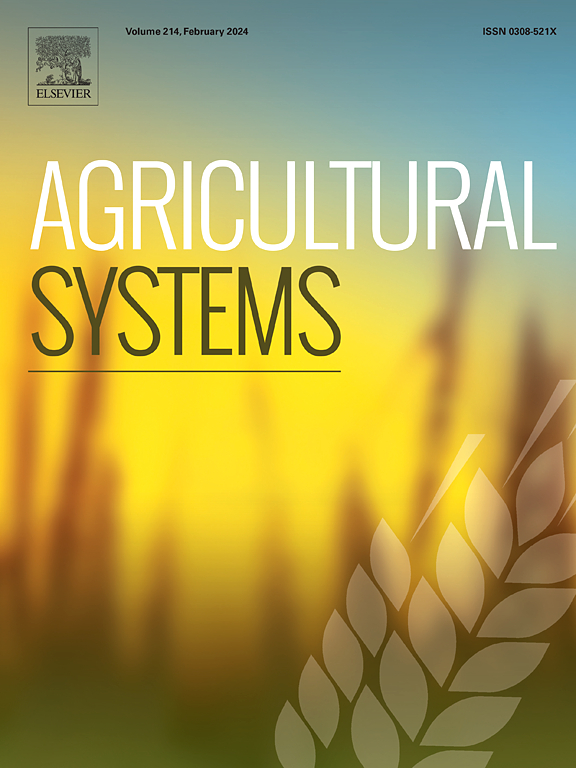Dire need for quantification of environmental impacts associated with breeding climate-resilient crops
IF 6.1
1区 农林科学
Q1 AGRICULTURE, MULTIDISCIPLINARY
引用次数: 0
Abstract
Context
As China's breadbasket, the Yangtze River Basin plays a critical role in global food security, yet its agricultural stability is increasingly threatened by the climate emergency.
Objective
This study aimed to (1) identify the critical climatic variables that drive wheat yield variability across Yangtze River Basin; (2) reveal the key climatic variables that contribute to regional yield gaps, and (3) quantify yield increase and associated environmental costs under current nitrogen application rates and estimate the nitrogen fertiliser required to achieve full yield potential with improved genetic traits.
Methods
We combined process-based crop model knowledge, fine-scale municipal wheat yield data (1980–2020) and statistical analytics to benchmark regional yield gaps under historical and future climates and we then analysed 8192 hypothetical genotypes with diverse yet realistic ranges of phenology, growth, radiation use efficiency and yield components to assess their impact on reducing yield gaps and associated environmental costs.
Results and conclusion
We found that many arable areas exhibited statistically significant correlations (R2 = 0.94) between climate and wheat yield variability. Changes in precipitation explained the largest proportion of yield variance (R2 = 0.38), while temperature (R2 = 0.31) and solar radiation (R2 = 0.29) exerted nearly identical influences on wheat yield fluctuations. Yield gaps were well explained by photothermal quotients, which ranged from 0.55 to 1.14 across the Yangtze River Basin. Due to increased extreme climatic events, simulated rainfed wheat yields decreased by 12 % and 24 % in 2050s under emissions scenarios SSP245 and SSP585, respectively. Adoption of cultivars with optimised traits (higher RUE and larger grain size) could increase grain yield by 61–80 % under current and future climate. However, trait-optimisation for yield revealed clear trade-offs for nitrogen demand (16–36 % increase), N2O emissions (30–50 % increase), greenhouse gas emission intensity (24–35 % increase) and nitrogen-use efficiency (13–21 % decrease), heralding dire ramifications for breeding programs that optimize traits for productivity benefits alone.
Significance
We advocate that crop breeding programs include sustainability indicators encompassing nitrogen demand, use, and use-efficiency to avoid environmental impacts associated with increasing yields to feed a burgeoning global population.

迫切需要量化与培育气候适应型作物相关的环境影响
作为中国的粮仓,长江流域在全球粮食安全中发挥着至关重要的作用,但其农业稳定正日益受到气候紧急情况的威胁。目的研究:(1)确定影响长江流域小麦产量变异的关键气候变量;(2)揭示导致区域产量差距的关键气候变量;(3)量化当前施氮量下的产量增加和相关环境成本,并估算通过改良遗传性状实现产量潜力所需的氮肥。方法结合基于过程的作物模型知识、精细尺度的城市小麦产量数据(1980-2020年)和统计分析,以历史和未来气候条件下的区域产量差距为基准,分析了8192个假设基因型,这些基因型具有物候、生长、辐射利用效率和产量成分的不同但现实范围,以评估它们对缩小产量差距和相关环境成本的影响。结果与结论许多耕地气候与小麦产量变异率呈显著相关(R2 = 0.94)。降水变化对小麦产量波动的影响最大(R2 = 0.38),而温度(R2 = 0.31)和太阳辐射(R2 = 0.29)对小麦产量波动的影响几乎相同。光热系数可以很好地解释产量差距,长江流域的光热系数在0.55 ~ 1.14之间。由于极端气候事件的增加,在SSP245和SSP585排放情景下,2050年代模拟旱作小麦产量分别下降12%和24%。在当前和未来气候条件下,采用具有优化性状(高RUE和大粒径)的品种可使粮食产量提高61 - 80%。然而,产量性状优化揭示了氮需求(增加16 - 36%)、N2O排放(增加30 - 50%)、温室气体排放强度(增加24 - 35%)和氮利用效率(减少13 - 21%)之间的明显权衡,预示着仅为了生产力效益而优化性状的育种计划将面临可怕的后果。我们提倡作物育种计划包括可持续性指标,包括氮素需求、使用和使用效率,以避免因增加产量而对环境造成影响,以养活不断增长的全球人口。
本文章由计算机程序翻译,如有差异,请以英文原文为准。
求助全文
约1分钟内获得全文
求助全文
来源期刊

Agricultural Systems
农林科学-农业综合
CiteScore
13.30
自引率
7.60%
发文量
174
审稿时长
30 days
期刊介绍:
Agricultural Systems is an international journal that deals with interactions - among the components of agricultural systems, among hierarchical levels of agricultural systems, between agricultural and other land use systems, and between agricultural systems and their natural, social and economic environments.
The scope includes the development and application of systems analysis methodologies in the following areas:
Systems approaches in the sustainable intensification of agriculture; pathways for sustainable intensification; crop-livestock integration; farm-level resource allocation; quantification of benefits and trade-offs at farm to landscape levels; integrative, participatory and dynamic modelling approaches for qualitative and quantitative assessments of agricultural systems and decision making;
The interactions between agricultural and non-agricultural landscapes; the multiple services of agricultural systems; food security and the environment;
Global change and adaptation science; transformational adaptations as driven by changes in climate, policy, values and attitudes influencing the design of farming systems;
Development and application of farming systems design tools and methods for impact, scenario and case study analysis; managing the complexities of dynamic agricultural systems; innovation systems and multi stakeholder arrangements that support or promote change and (or) inform policy decisions.
 求助内容:
求助内容: 应助结果提醒方式:
应助结果提醒方式:


